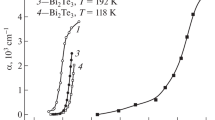Abstract
The energy of plasma oscillations of free charge carriers in bismuth crystals ℏωp can be qual to the band gap at the L point of the Brillouin zone E gL as a result of doping with an acceptor impurity. Variation in the edge shape and splitting of the minimum in the plasma reflection are observed in experimental studies of reflection under normal incidence of radiation on the crystal. An analysis of the totality of available experimental data shows that the above special features are caused by interaction of elementary excitations (such as the plasma oscillations) with band-to-band transitions. It became possible for the first time to ascertain the composition of the bismuth crystals for which the condition ℏωp=E gL is satisfied and observe the variation in the characteristics of the plasma oscillations of free charge carriers, which occurs as a result of electron-plasmon interaction.
Similar content being viewed by others
References
P. A. Fal’kovskii, Usp. Fiz. Nauk 94(1), 3 (1968) [Sov. Phys. Usp. 11, 1 (1968)].
V. S. Édel’man, Zh. Éksp. Teor. Fiz. 64, 1734 (1973) [Sov. Phys. JETP 37, 875 (1973)].
T. M. Lifshits, A. B. Ormond, E. T. Chirkova, and A. Ya. Shul’man, Zh. Éksp. Teor. Fiz. 72, 1130 (1977) [Sov. Phys. JETP 45, 591 (1977)].
N. P. Stepanov and V. M. Grabov, Opt. Spektrosk. 84, 581 (1998) [Opt. Spectrosc. 84, 515 (1998)].
V. L. Bonch-Bruevich and E. G. Landsberg, Phys. Status Solidi 29, 9 (1968).
N. S. Baryshev, Fiz. Tekh. Poluprovodn. (Leningrad) 9, 2023 (1975) [Sov. Phys. Semicond. 9, 1324 (1975)].
A. S. Mal’tsev, V. M. Grabov, and A. A. Kukharskii, Opt. Spektrosk. 58, 927 (1985) [Opt. Spectrosc. 58, 567 (1985)].
P. Grosse, Freie Electronen in Festköpern (Springer-Verlag, Heidelberg, 1979; Mir, Moscow, 1982).
V. M. Grabov, N. P. Stepanov, B. E. Vol’f, and A. S. Mal’tsev, Opt. Spektrosk. 69, 134 (1990) [Opt. Spectrosc. 69, 82 (1990)].
V. V. Sobolev and V. V. Nemoshkalenko, Methods of Computational Physics in the Theory of Solid State (Naukova Dumka, Kiev, 1998).
J. C. Slater, Insulators, Semiconductors, and Metals (McGraw-Hill, New York, 1967; Mir, Moscow, 1969).
P. A. Wolff, Phys. Rev. Lett. 24(6), 266 (1970).
Author information
Authors and Affiliations
Additional information
__________
Translated from Optika i Spektroskopiya, Vol. 92, No. 5, 2002, pp. 775–779.
Original Russian Text Copyright © 2002 by Stepanov, Grabov.
Rights and permissions
About this article
Cite this article
Stepanov, N.P., Grabov, V.M. Optical effects caused by coincidence between the energies of the plasma oscillations and the band-to-band transition in bismuth crystals doped with an acceptor impurity. Opt. Spectrosc. 92, 710–714 (2002). https://doi.org/10.1134/1.1481136
Received:
Accepted:
Issue Date:
DOI: https://doi.org/10.1134/1.1481136




